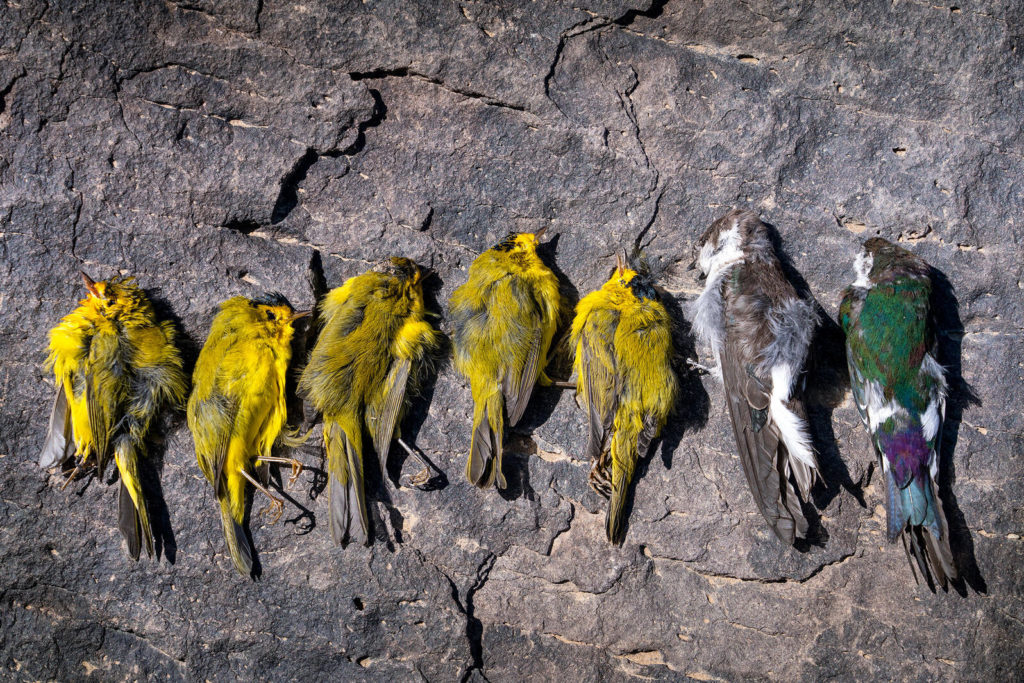Everything is Fine!

A dozen dead Barn and Violet-green Swallows huddled together on the dusty desert floor of southern New Mexico. Numerous Western Bluebirds packed into a crevice in southern Colorado as if they panicked. Sparrows, lined up almost wing-to-wing, lying limply along the banks of the Rio Grande.
These are just a few of the grisly discoveries recently made in what is likely a mass death event for migratory birds occurring across the Southwest. At the moment, there is no clear explanation.
The die-off is “unprecedented,” says Martha Desmond, an avian ecologist at New Mexico State University (NMSU) in Las Cruces, who is leading the research team documenting the event. She estimates that hundreds of thousands of birds have died across at leastfive U.S. states and in four Mexican states. “It’s enormous, the extent of this,” Desmond says. “We haven’t counted all the species yet, but there are lots of species involved.” Online reports show dead owls, warblers, hummingbirds, loons, flycatchers, woodpeckers, and more—representing the wide diversity of migrants heading south to their wintering grounds.
If the deaths continue, Desmond says the total could reach six figures—a devastating number she calculated using the average annual fall migration in the region.
The exact reasons for the deaths aren’t yet known. A cold snap that brought snow, wind, and low temperatures across the region on September 8 and 9 could have forced birds to migrate early or brought down birds already weak from migration. Similarly, wildfires raging along the West Coast might have spurred premature departures while also interfering with birds’ migratory routes, vision, and breathing. Some combination of both factors may also be the cause, but experts emphasize that nothing has been proven so far. “There’s more questions than answers still,” says Jon Hayes, executive director of Audubon Southwest.
Living through the last hundred years of the world is great….
But hey, I’m sure Mike Davis will cheer us up!
The Eastern Mojave Desert is a grim example. En route from Los Angeles to Las Vegas, 20 minutes away from the state line, there’s an exit from I-15 to a two-lane blacktop called Cima Road. It’s the unassuming portal to one of North America’s most magical forests: countless miles of old-growth Joshua trees mantling a field of small Pleistocene volcanoes known as Cima Dome. The monarchs of this forest are 45 feet high and 1,000 years old. In mid-August an estimated 1.3 million of these astonishing giant yuccas perished in the lightning-ignited Dome Fire.
This is not the first time that the Eastern Mojave has burned. A megafire in 2005 scorched a million acres of desert, but it spared the Dome, the heart of the forest. Over the last generation, an invasion of red brome has created a flammable understory to the Joshuas and transformed the Mojave into a fire ecology. (Invasive cheatgrass has played this role in the Great Basin for decades.)
Desert plants, unlike California oaks and chaparral, are not fire-adapted, so their recovery may be impossible. Debra Hughson, the chief scientist at the Mojave National Preserve, described the fire as an extinction event. “The Joshua trees are very flammable. They’ll die, and they won’t come back.”
Our burning deserts are regional expressions of a global trend. Mediterranean vegetation has coevolved with fire; indeed, oaks and most chaparral plants require episodic fire to reproduce. But routine extreme fire in Greece, Spain, Australia, and California is now overriding Holocene adaptations and producing irreversible changes in the biota.
Capitalism is the greatest crime ever committed against the planet.


